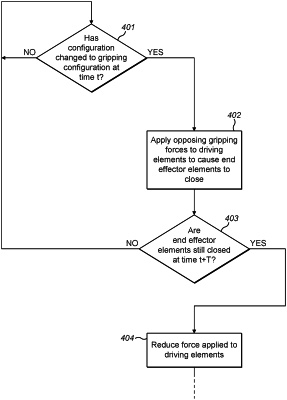| CPC A61B 34/35 (2016.02) [A61B 34/77 (2016.02); B25J 9/1612 (2013.01); B25J 15/0019 (2013.01)] | 21 Claims |

|
1. A control system configured to control manipulation of a surgical instrument in response to manipulation of a remote surgeon input device, the surgical instrument comprising opposable first and second end effector elements connected to a shaft by an articulated coupling, the articulated coupling comprising a first joint driveable by a first pair of driving elements so as to permit the first end effector element to rotate, and a second joint driveable by a second pair of driving elements so as to permit the second end effector element to rotate, the control system configured to:
detect a change of configuration of the surgeon input device to a gripping configuration at time t;
respond to the change of configuration of the surgeon input device to the gripping configuration by commanding gripping forces to be applied to the first and second pairs of driving elements, so as to cause the first and second end effector elements to rotate in opposing rotational directions towards each other with a gripping closing force to an overgripping closed configuration;
detect if the first and second end effector elements are still in any overgripping closed configuration at time t+T, wherein T is dependent on instrument type such that T is different for different instrument types; and
if it is detected that the first and second end effector elements are still in any overgripping closed configuration at time t+T, command a reduction in the force applied to the first and second pairs of driving elements, thereby causing the first and second end effector elements to subsequently be held in a further closed configuration with a reduced closing force.
|